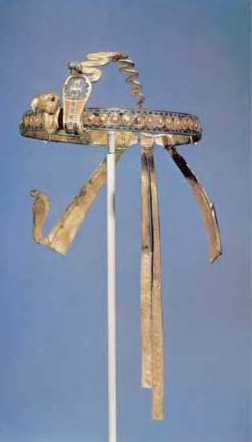The Tutankhamun Exhibit
Jewelry and Ornamentation

Gold Diadem
Concealed beneath the gold mask, which covered the head and shoulders of Tutankhamun's mummy, was an elegant gold diadem, closely resembling in style the diadem worn by the king in two of the scenes represented on the small gold shrine found in his tomb. Very probably it was used in his lifetime, placed over a wig. The vulture's head and the cobra, insignia of his sovereignty over Upper and Lower Egypt, were not transferred from one diadem to another - a feature that would suggest that this diadem was one of a set.
Interchangeability of such a kind was, however, unusual and is hard to explain, unless it was by reason of the amount of valuable material contained in the insignia. Apart from the obsidian eyes, the vulture's head is made of solid gold, its wrinkled occiput, and short, stiff parietal feathers at the back of the neck giving it a most lifelike appearance. The cobra's head and hood are inlaid with lapis lazuli, faience, carnelian, and glass, and the long, curly tail, chase to imitate the serpent's scales, is curved to fit over the top of the wig. On the front of the hood, crossing the central markings, is the emblem of the goddess Neith. When wrapping the mummy, the embalmers did not attach the vulture's head and the cobra to the diadem, possibly because the mask would not have fitted over them, but placed them lower on the body, the vulture's head over the right (southern) thigh and the cobra over the left thigh.
The vulture-goddess Nekhbet, whose name means "She who belongs to Nekheb," was originally simply the local goddess of Nekheb, the modern Elkab on the east bank of the Nile, about halfway between Luxor and Aswan. She owed her importance in dynastic times to her previous adoption by the predynastic kings of Upper Egypt, whose seat lay at Nekhen (Hierakonpolis) across the river from Nekheb. According to tradition, the last of these kings, Menes, completed the conquest of Lower Egypt, the patron deity of whose kings was the cobra-goddess Wadjet, and united the two kingdoms under his sovereignty in about 3100 B.C. The vulture and the cobra thus became the symbols of this unification and also the tutelary deities of the kings. Their heads were often placed side by side on the front of the headdresses worn by kings on state occasions, and on the headdresses of their statues and other representations. Frequently the entire cobra was reproduced in this setting. It is said that the species of vulture (Gyps fulvus) has its habitat at the present day in Middle and Upper Egypt and further south, but is seldom seen in Lower Egypt.
Circlets were a common feature in Egyptian dress, worn by both men and women, regardless of class and at every period. In origin their purpose was purely utilitarian, a device to confine the hair and prevent it from falling over the eyes. A simple band of rope or fabric tied in a knot at the back of the head gave all the protection necessary. Scenes carved on the walls of Old Kingdom tombs depict boatmen holding long staves in their hands and wearing such circlets while engaged in mock combat. The first step in the process of development from the simple to the ornamental was certainly taken, albeit unconsciously, when flowers, usually the blue lotus and its buds, were inserted between the band and the head. Besides being ornamental, the insertion of flowers, and particularly the blue lotus, surrounded the wearer with a fragrant and refreshing aroma, though doubtless of very limited duration in a hot climate. Banqueting scenes regularly show the female participants, whether guests, attendants, or musicians, wearing floral circlets on the crowns of their wigs, sometimes with a fresh supply in reserve placed in a dish nearby. Even in this developed form the circlet still fulfilled its original function of keeping the hair, or the wig, in position.
Once the circlet had assumed an ornamental character, its reproduction in more costly and permanent materials as an object of adornment was a natural consequence. But the use of such materials necessitated the stylization of the individual features, and Tutankhamun's diadem provides a very clear example of the way in which the adaptation could be accomplished. The gold headband is decorated with carnelian roundels (some of which are modern) in contiguous cloisons, each roundel being attached by a central rivet capped with a gold cloison inlaid with a disk of red chalcedony and the bow being in the form of two papyrus umbel cloisons inlaid with malachite. The two ends of the band hang down beneath the know as streamers, each decorated in the same fashion as the band itself. Two ribbon-like appendages at the sides resemble the streamers in their decoration, but they are wider and each ribbon has a massive gold cobra attached to its front edge. These two features and the royal insignia over the brow are the only elements in the diadem that are not adapted directly from the floral circlet with a beaded headband.




